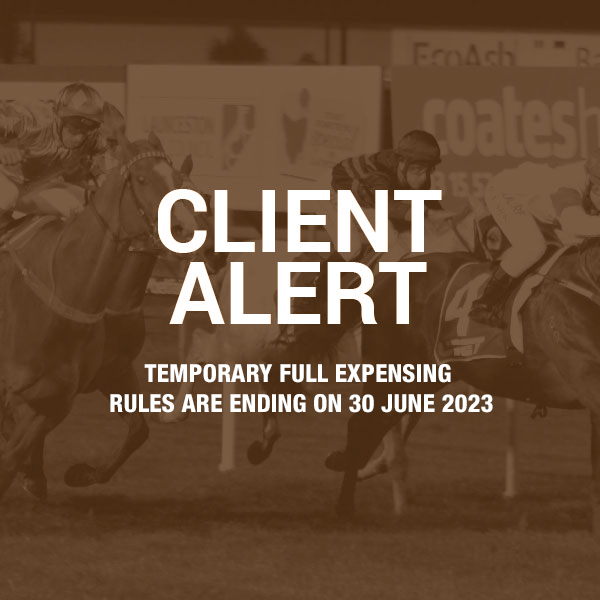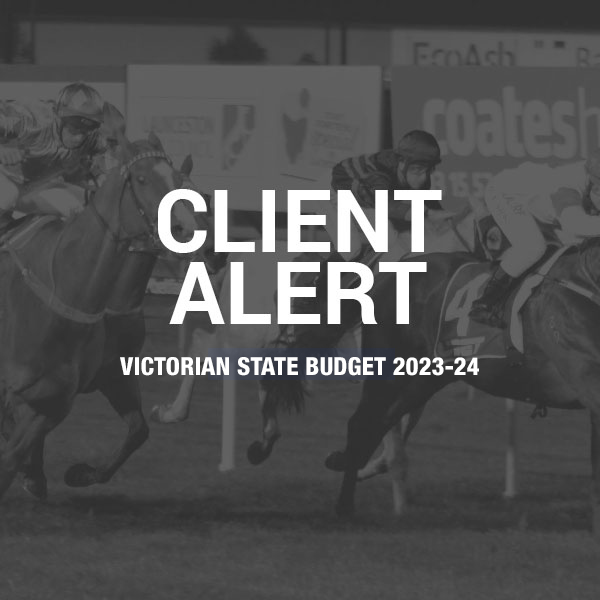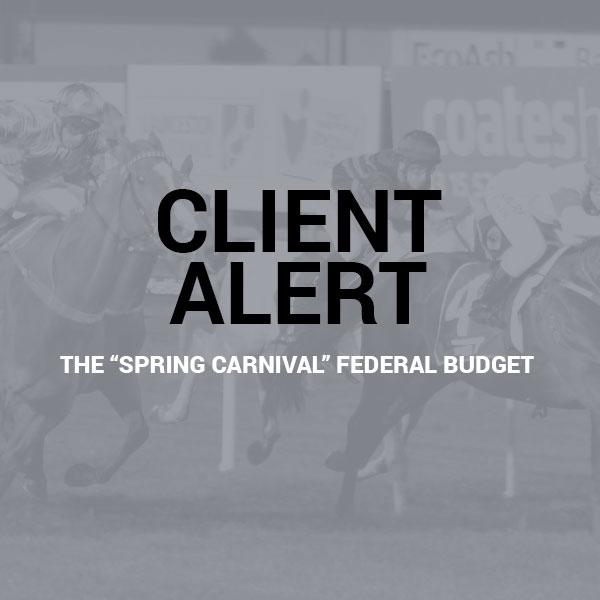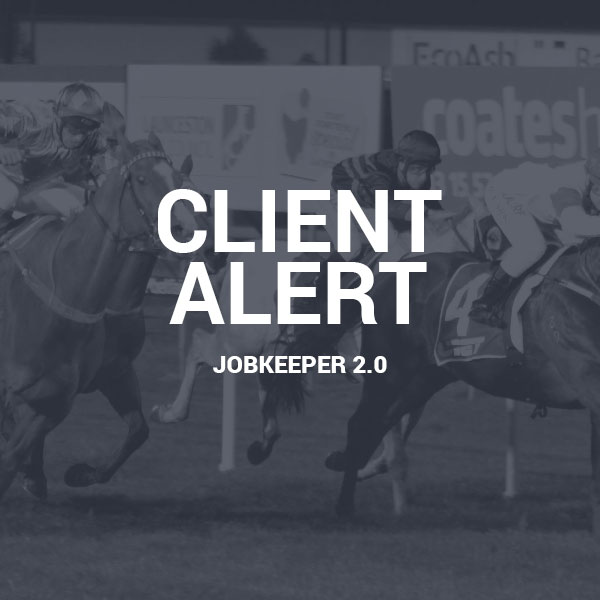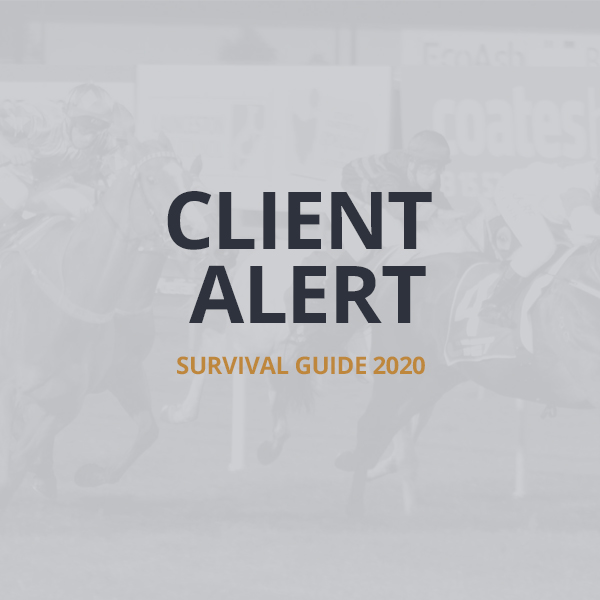JobKeeper 2.0 – are you ready & able?
Unfortunately the end is near for some (JobKeeper 1.0 ends on Sunday 27 September) especially given the rescheduled Magic Millions sale in July making it difficult for vendors to meet the new testing period for September quarter (drop in revenue >30%). Employers should act now to assess if they and their employees still qualify for JobKeeper and whether or not the current rate of pay needs to be changed from 28 September.
The Federal Government have released details of its extension to the JobKeeper scheme beyond September 2020. As previously announced, the JobKeeper payment will be extended for two periods, being the December 2020 quarter and March 2021 quarters.
If you are currently receiving JobKeeper you cannot assume that beyond the 28 September you will remain in the system. Employers will need to retest their eligibility and for those in the commercial thoroughbred industry, the first retesting period of September quarter 2020 may be problematic simply due to the rescheduling of the recent Magic Millions sale that commenced on 27 July 20 (previously held in the September quarter each year).
There is a bit of work to complete if you want to participate in the JobKeeper program going forward – not only do you need to consider your eligibility as an employer but you will need to determine the different category/rate of JobKeeper that may apply to your employees based on the number of hours they work for you.
The extended scheme will apply at a top rate of $1,200 per JobKeeper fortnight until 3 January 2021, dropping to $1,000 until 28 March 2021. Lower rates will apply for some part-time and casual employees. The first JobKeeper fortnight under the new scheme will begin on 28 September 2020 requiring prompt consideration of eligibility for the payments and any administrative requirements.
Background
The key features of JobKeeper 2.0 are:
- the duration of the scheme has been extended, for the periods 28 September 2020 to 3 January 2021 (“the First Extension Period”) and 4 January 2021 to 28 March 2021 (“the Second Extension Period”), provided relevant eligibility requirements are satisfied;
- employers are required to separately test their eligibility for each period based on an actual decline in turnover for a quarter; and
- reduced rates of payment apply, determined by the average number of hours worked by an employee during the relevant period.
The new rules provide the ATO with powers around the turnover test and with respect the higher and lower rates. Those powers become effective from 16 September 2020. It is expected there will be additional rules released in the coming weeks. The below answers are subject to change where additional guidance from the ATO is released.
Eligible employers
What conditions do I need to satisfy to continue to be eligible under JobKeeper 2.0?
To be eligible to continue receiving payments under the extended scheme, businesses and not-for-profits will need to demonstrate their actual GST turnover has fallen in the September 2020 quarter (for payments during “the First Extension Period”) or the December 2020 quarter (for payments during the “Second Extension Period”) relative to a comparable period (generally the corresponding quarter in 2019).
The decline in GST turnover (usually >30%) for selected period will be with reference to actual numbers ie: put simply, GST turnover reported in G1 of BAS Sept 20 quarter vs GST turnover reported Sept 19 quarter in G1. (This is different to JobKeeper 1.0 where testing periods could be chosen (month/quarter) and a projected turnover figure used where applicable.)
Each of these periods will be tested separately, meaning businesses can be eligible for one or both periods (or neither). Importantly, businesses will still be required to meet the other eligibility conditions that applied under the original JobKeeper scheme (i.e. carried on a business or pursued its non-profit objectives in Australia at 1 March 2020).
Can I qualify for JobKeeper 2.0 without having enrolled in the original scheme?
Enrolment in the original JobKeeper (i.e. prior to 28 September 2020) is not a requirement for payments during the first or second Extension Period. New entrants are permitted to enrol for either of these periods provided they meet the other eligibility conditions that apply.
Are the Commissioner’s alternative tests still available?
The Commissioner retains the power to determine that an alternative test applies to a particular class of entities where there is no relevant comparison period.
The Coronavirus Economic Response Package (Payments and Benefits) Alternative Decline in Turnover Test Rules (No. 2) 2020 legislative instrument has now been registered by the commissioner, setting out the revised alternative tests for JobKeeper fortnights from 28 September onwards.
The new alternative tests remain broadly in line with the original, with the same seven circumstances available to entities where there is not an appropriate relevant comparison period in 2019.
These include businesses that started after the comparison period, businesses that acquired or disposed part of the business, and where a business restructure changed the entity’s turnover.
The alternative tests also account for businesses that had a substantial increase in turnover, were affected by drought or natural disaster, have an irregular turnover, and had sole traders or small partnerships that experienced sickness, injury or leave during the comparable period.
Eligible employees
Who is an eligible employee?
The eligibility rules require an individual to satisfy;
- An employment test (full time, part-time or casual employee)
- Age test (18 years or over, unless independent or not studying full-time)
- Residency test as at the relevant date.
For fortnights commencing on 3 August 2020, whether an individual is an eligible employee can be tested as at 1 July 2020, instead of 1 March 2020. This extends the application of JobKeeper to employees that have been engaged by an employer since the scheme was originally introduced.
Employers already enrolled in JobKeeper prior to 3 August 2020 are not required to retest employees that satisfied the eligibility requirements as at 1 March 2020.
Who is an eligible business participant?
The rules regarding eligible business participants have not changed. An individual will only be an eligible business participant if they meet the relevant criteria as at 1 March 2020 and continue to be actively engaged in the business in each JobKeeper fortnight.
Payment rates
What are the new payment rates for employees?
Under the amendments, the maximum payment available under JobKeeper 2.0 will be reduced from 28 September 2020 to $1,200 for the First Extension Period and $1,000 for the Second Extension Period. The maximum payment will be available only to those eligible employees and eligible business participants that satisfy a “work hours test” (more than 80 hours in the relevant period), regardless of their hours of employment within the fortnight itself. Employees or business participants that do not satisfy the work hours test will be eligible for the reduced payment rate of $750 (for the First Extension Period) or $650 (for the Second Extension Period).
For the employer to be eligible for the payment at the higher rate for the employee, the business must notify the Commissioner that the higher rate applies. The employer must additionally notify the employee whether the higher or lower rate applies.
For those that anticipate being eligible for payments under JobKeeper 2.0, employers can now begin assessing whether their employees are likely to be higher or lower rate.
How do I determine which payment rate applies for an employee?
The payment rate for eligible employees and business participants will depend on whether the individual satisfies a work hours test. For an employee, this test requires that the total hours of work, paid leave and paid absence on public holidays was 80 hours or more during the relevant period (“the reference period”) prior to 1 March 2020 or 1 July 2020 (whichever is higher for the employee).
The reference period is determined by the normal pay cycle for the employer. If the employer pays on a weekly or fortnightly basis, the test will consider the number of hours worked in the 28-day period ending at the end of the last pay cycle before 1 March 2020 or 1 July 2020.
For example, a business normally pays its staff fortnightly in arrears. Its last pay cycle prior to 1 March 2020 ended on Tuesday 25 February 2020. The employer will consider the number of hours worked by the individual in the 28-day period ending on 25 February 2020 (i.e. between Wednesday 29 January
2020 and Tuesday 25 February 2020). Where the employee worked more than 80 hours during this period, the employer will be entitled to the JobKeeper payment at the higher rate for that employee for both Extension Periods (if the employer qualifies for both).
Does the payment rate apply to both the First and Second Extension Periods?
As the work hours test is based on a previous period (i.e. February or June 2020), the higher or lower rate for the employee or business participant will apply for both Extension Periods and will only need to be tested once. That is, the hours worked by the employee in the September or December quarters are not relevant in determining whether the higher rate applies.
How do I determine which payment rate applies for an eligible business participant?
The payment rate for eligible employees and business participants will depend on whether the individual satisfies a work hours test. For a business participant, this test requires that the individual was actively engaged in the business for at least 80 hours during the month of February 2020. In addition, the individual must give the business (or to the Commissioner if the individual is a sole trader) a notice outlining that it meets this condition, for the business to be eligible for the payment at the higher rate.
Wage condition
When am I required to pay my employees for the first fortnight?
It continues to be a requirement under JobKeeper 2.0 that an employer is required to meet the wage condition (i.e. pay the minimum JobKeeper payment to each eligible employee) by the end of each JobKeeper fortnight. As outlined in the Explanatory Statement, it is expected that the ATO will provide an extension of time to allow an entity to meet the wage condition for the first fortnights in each extension period.
What are the next steps?
For more information or to review your existing arrangements and determine what steps are required, please contact a Stable Financial team member.


